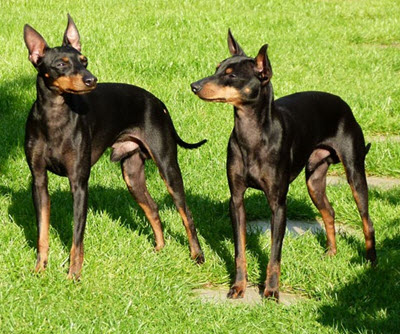English Toy Terrier (Black & Tan)
The English Toy Terrier (Black & Tan) was developed from the Old English Black and Tan Terrier, and is a close relative of the Manchester Terrier. The Italian Greyhound is also believed to have contributed with genetic material to the ETT B&T. The ETT B&T is considerably smaller than the Old English Black and Tan Terrier and the Manchester Terrier, and also more fine boned.
 When the first all-breeds dog show took place in the United Kingdom, a lot of Black and Tan Terriers participated. They were divided into different groups based on weight, and this weight division eventually led to the recognition of a heavy breed – the Manchester Terrier – and a low-weight breed – the Black and Tan Terrier (Miniature) in the 1920s. In 1962, the name of the latter was changed to English Toy Terrier (Black and Tan).
When the first all-breeds dog show took place in the United Kingdom, a lot of Black and Tan Terriers participated. They were divided into different groups based on weight, and this weight division eventually led to the recognition of a heavy breed – the Manchester Terrier – and a low-weight breed – the Black and Tan Terrier (Miniature) in the 1920s. In 1962, the name of the latter was changed to English Toy Terrier (Black and Tan).
Today, the English Toy Terrier (Black & Tan) is a rare breed and the UK Kennel Club is concerned about its possible extinction. To promote the breed and prevent genetic problems due to severe inbreeding, they have opened their stud book to allow the North American Toy Manchester Terrier to be re-registered as English Toy Terrier (Black & Tan) – provided that the dog is a certified toy and not a standard.
Rat-killing
The English Toy Terrier (Black & Tan) hails from dogs used both to control vermin and for participation in rat pit contests. Rat pit contests were a popular past time in Victorian England and involved placing rat-catching dogs, typically terriers, in a circle or pit with a number of rats. Before the contest started, spectators would bet on which dog would kill its quota of rats in the fastest time.
Some of these dogs were truly amazing rat-killers. In 1848, a black and tan terrier named Tiny killed 300 rats in less than an hour, despite weighing just 5.5 lbs.
Rat pit contests have been outlawed in the UK for a very long time, but the UK Kennel Club breed standard for the ETT B&T still calls for alertness and a dog that is never unduly nervous. The dog’s ancestors were brave and skilled in the rat pit, and this should be noticeable even in today’s English Toy Terriers.
Names
- English Toy Terrier (Black & Tan) is used by the UK Kennel Club.
- The name Toy Manchester Terrier is used in North America. In 1958, declining numbers of the Manchester Terrier and the smaller Black and Tan in North America prompted the American Kennel Club to re-define them as a single breed with two varieties: Standard and Toy.
- Another common name for this breed is Miniature Black and Tan.
Short facts about the English Toy Terrier (Black & Tan)
| Breed group (UK Kennel Club) | Toy |
| Size | Small |
| Coat length | Short |
| Shedding | Yes |
| Grooming requirements | Once a week |
| Exercise requirements | In the lower range |
| Expected life span | 12+ years |
Excerpts from the UK Kennel Club Breed Standard
| General appearance | Well balanced
Elegant Compact Sleek Cleanly built |
| Size & Weight | Ideal weight is 2.7-3.6 kg
Ideal height is 25-30 cm at the shoulder |
| Body etc | Compact body
Head and legs proportionate Long and slightly arched neck Well laid back shoulders Narrow and deep chest Very slightly curving back, from behind the should to the loin Gently rounded buttocks |
| Head etc | Long head
Flat skull Wedge-shaped without emphasis of cheek muscles Well filled up under the eyes Jaws strong and held tightly together within compressed lips Perfect scissor bite Teeth level and strong Black nose Relatively small eyes, not prominent Almond-shaped eyes Obliquely set eyes Sparkling eyes Dark to black eyes No light shading from iris Candle-flame shaped ears with slightly pointed tips Ears placed high upon the back of the skull, with the entire inside of the ear front-facing An ear bent forward should not reach the eye Ear carriage must be erect in dogs aged 9 month and above |
| Coat & Colour | Thick, close and glossy coat
A density of short hair required Black & Tan, with the black being ebony Colours should not be running or blending into each other White hair forming a patch is totally undesirable |
| Tail | Thick at the root, tapering to point
Set low Not reaching below the hock |
| Feet | Dainty
Compact Split up between toes Well arched Two middle toes on front feet longer than other toes Hind feet similar to cat paws Jet black nails Hare feet are undesirable |
